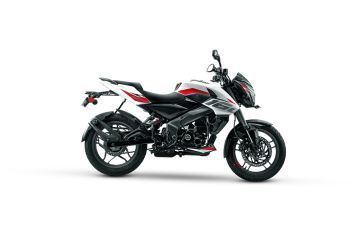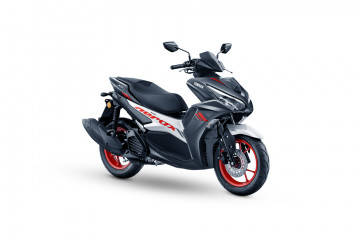Explore all New Cars of 2025
Bajaj Pulsar NS160 vs Yamaha Aerox 155
Pulsar NS160 vs Aerox 155
| Key Highlights | Pulsar NS160 STD | Aerox 155 STD |
|---|---|---|
| Engine Type | Oil Cooled, Twin Spark, 4-Valve FI DTS-i | Liquid cooled, 4-stroke, SOHC, 4-valve |
| Max Power | 17.2 PS @ 9000 rpm | 15 PS @ 8000 rpm |
-
Bajaj Pulsar NS160
 Rs. 1.47 Lakh EMI - Rs. 4,400 View January OffersYamaha Aerox 155
Rs. 1.47 Lakh EMI - Rs. 4,400 View January OffersYamaha Aerox 155 Rs. 1.49 Lakh EMI - Rs. 4,305 View January Offers
Rs. 1.49 Lakh EMI - Rs. 4,305 View January Offers
Pulsar NS160 vs Aerox 155 Key Highlights
| Basic Info | Bajaj Pulsar NS160 STD | Yamaha Aerox 155 STD |
|---|---|---|
| Rating |
326 reviews
|
146 reviews
|
| Brand Name | Bajaj | Yamaha |
| Ex-Showroom Price | Rs. 1.47 Lakh Get On-Road Price | Rs. 1.49 Lakh Get On-Road Price |
| Engine Type | Oil Cooled, Twin Spark, 4-Valve FI DTS-i | Liquid cooled, 4-stroke, SOHC, 4-valve |
| Max Power | 17.2 PS @ 9000 rpm | 15 PS @ 8000 rpm |
| Fuel Type | Petrol | Petrol |
| Colors | ||
| Brakes Front | Disc | Disc |
| Brakes Rear | Disc | Drum |
| Wheel Size | Front :-431.8 mm,Rear :-431.8 mm | Front :-355.6 mm,Rear :-355.6 mm |
| Wheels Type (Pressed Steel/ Alloy) | Alloy | Alloy |
| ABS | Dual Channel | Single Channel |
| Starting | Self Start Only | Self Start Only |
| Speedometer | Digital | Digital |
| EMI |
Rs. 4,400
@
11.99% (36 months)
|
Rs. 4,305
@
9.45% (36 months)
|
| Insurance | Rs. 11,165 Pulsar NS160 Insurance | Rs. 11,203 Aerox 155 Insurance |
| Brochure |
Download
Brochure
|
Download
Brochure
|
Engine |
|
||||||||||||||||||||||||||||||||||||||||||||||||||||||||||||||||||||||||
|---|---|---|---|---|---|---|---|---|---|---|---|---|---|---|---|---|---|---|---|---|---|---|---|---|---|---|---|---|---|---|---|---|---|---|---|---|---|---|---|---|---|---|---|---|---|---|---|---|---|---|---|---|---|---|---|---|---|---|---|---|---|---|---|---|---|---|---|---|---|---|---|---|---|
Brakes |
|
||||||||||||||||||||||||||||||||||||||||||||||||||||||||||||||||||||||||
Performance |
|
||||||||||||||||||||||||||||||||||||||||||||||||||||||||||||||||||||||||
Tyres |
|
||||||||||||||||||||||||||||||||||||||||||||||||||||||||||||||||||||||||
Dimensions |
|
||||||||||||||||||||||||||||||||||||||||||||||||||||||||||||||||||||||||
Electricals |
|
||||||||||||||||||||||||||||||||||||||||||||||||||||||||||||||||||||||||
Features |
|
Pros and Cons
- Positives
- Negatives
- It packs a pretty powerful engine
- Shares the capable perimeter frame with larger Pulsars
- Stopping power is pretty good.
- Amazing performance
- Incredible handling
- Sporty looks
- Generous under-seat storage
- Engine refinement could have been better
- It isn’t feature-rich like its segment rivals
- It is the heaviest 160cc motorcycle.
- Jarring ride quality
- Brakes not powerful enough
- No floor space
Is Yamaha Aerox 155 Better Than Bajaj Pulsar NS160?
60% users have chosen Yamaha Aerox 155 over Bajaj Pulsar NS160 in a survey being conducted on zigwheels.com.
Apart from this survey a total of 1711 users have also rated Yamaha Aerox 155 and Bajaj Pulsar NS160 on some really important factors like Mileage , performance, comfort, safety etc. and have given their personal opinions about these bikes.
As per the users experiences Yamaha Aerox 155 is a winner for you if you are seriously looking for mileage, performance, comfort and features in your bike. On the basis of maintenance user have rated both the bikes equally.
Before making your decision you should also consider the unbiased and thorough analysis of these bikes on every aspect by our auto experts who have summarised the analysis in pros, cons and final conclusion..
| Ratings Factor | Aerox 155 | Pulsar NS160 |
|---|---|---|
| Mileage | 4.2 | 3.8 |
| Performance | 4.5 | 4.4 |
| Comfort | 4.3 | 4.2 |
| Maintenance | 3.9 | 3.9 |
| Features | 4.6 | 4.4 |
Videos of Bajaj Pulsar NS160 and Yamaha Aerox 155
-
2022 Performance Scooter Comparison - Yamaha Aerox 155, Aprilia SR 160, TVS NTorq 125 And More 6 Feb, 2022 10047 views
-
2023 Bajaj Pulsar NS200 And Pulsar NS160 First Ride Review - Road + Track | USD Fork Added 25 Mar, 2023 18574 views
-
160cc Sporty Commuters Compared On Acceleration, Fuel Efficiency, Price And Features | ZigWheels 30 May, 2023 5356 views
-
2023 Bajaj Pulsar NS160 & Pulsar NS200 Walkaround | Revised hardware, new features and…? | Zigwheels 14 Mar, 2023 7115 views
-
Bajaj Pulsar NS 160 (2017) : The Good And The Bad : PowerDrift 15 Aug, 2017 465730 views
-
Bajaj Pulsar NS160 (2017) : First Look : PowerDrift 16 Jul, 2017 283082 views
-
DIY: How to Lube your chain: PowerDrift 7 May, 2014 74820 views
-
Yamaha Aerox 155 Road Test Review | Acceleration, Fuel Efficiency, Practicality Test & More 21 Nov, 2021 8089 views
-
Yamaha Aerox 155 Walkaround Video | India’s Fastest Scooter 1 Oct, 2021 14482 views
Bajaj Pulsar NS160 Comparison with Similar Bikes
-
 BajajPulsar NS160Rs. 1.47 LakhvsPulsar NS160 vs Apache RTR 160 4V
BajajPulsar NS160Rs. 1.47 LakhvsPulsar NS160 vs Apache RTR 160 4V TVSApache RTR 160 4VRs. 1.24 Lakh
TVSApache RTR 160 4VRs. 1.24 Lakh -
 BajajPulsar NS160Rs. 1.47 LakhvsPulsar NS160 vs Hunter 350
BajajPulsar NS160Rs. 1.47 LakhvsPulsar NS160 vs Hunter 350 Royal EnfieldHunter 350Rs. 1.49 Lakh
Royal EnfieldHunter 350Rs. 1.49 Lakh
Yamaha Aerox 155 Comparison with Similar Bikes
-
 YamahaAerox 155Rs. 1.49 LakhvsAerox 155 vs RayZR 125 Fi Hybrid
YamahaAerox 155Rs. 1.49 LakhvsAerox 155 vs RayZR 125 Fi Hybrid YamahaRayZR 125 Fi HybridRs. 92,880
YamahaRayZR 125 Fi HybridRs. 92,880
Latest News on Bajaj Pulsar NS160 and Yamaha Aerox 155
-
 Bajaj Pulsar NS160 Flex Fuel Showcased At IBET (India Bio-Energy And Tech) Expo 20244 Sep, 2024 | By Team ZigWheels
Bajaj Pulsar NS160 Flex Fuel Showcased At IBET (India Bio-Energy And Tech) Expo 20244 Sep, 2024 | By Team ZigWheels -
 2024 Yamaha Aerox Alpha Launched Internationally20 Dec, 2024 | By Team ZigWheels
2024 Yamaha Aerox Alpha Launched Internationally20 Dec, 2024 | By Team ZigWheels -

-
 This Week's Top Bike News: Yamaha Aerox S, Aprilia 660 Trio And RSV4 Factory, Triumph Tiger 900 Range Launched And More20 Apr, 2024 | By Team ZigWheels
This Week's Top Bike News: Yamaha Aerox S, Aprilia 660 Trio And RSV4 Factory, Triumph Tiger 900 Range Launched And More20 Apr, 2024 | By Team ZigWheels -
 2024 Bajaj Pulsar NS160 And Pulsar NS200 Launched27 Feb, 2024 | By Team ZigWheels
2024 Bajaj Pulsar NS160 And Pulsar NS200 Launched27 Feb, 2024 | By Team ZigWheels -
 Yamaha Aerox 155 Version S: Features Explained19 Apr, 2024 | By Team ZigWheels
Yamaha Aerox 155 Version S: Features Explained19 Apr, 2024 | By Team ZigWheels -
 2024 Bajaj Pulsar NS200 And Bajaj Pulsar NS160 Unveiled Ahead Of Launch: Now More Feature-packed19 Feb, 2024 | By Team ZigWheels
2024 Bajaj Pulsar NS200 And Bajaj Pulsar NS160 Unveiled Ahead Of Launch: Now More Feature-packed19 Feb, 2024 | By Team ZigWheels -
 BREAKING: Yamaha Aerox 155 Version S Launched In India At Rs 1.50 Lakh17 Apr, 2024 | By Team ZigWheels
BREAKING: Yamaha Aerox 155 Version S Launched In India At Rs 1.50 Lakh17 Apr, 2024 | By Team ZigWheels -
 Updated Bajaj Pulsar NS160 Spotted Testing19 Jan, 2024 | By Team ZigWheels
Updated Bajaj Pulsar NS160 Spotted Testing19 Jan, 2024 | By Team ZigWheels -
 This Zontes Scooter Makes As Much Power As The KTM 125 Duke6 Feb, 2023 | By Team ZigWheels
This Zontes Scooter Makes As Much Power As The KTM 125 Duke6 Feb, 2023 | By Team ZigWheels
Recently Asked User Questions
- Bajaj Pulsar NS125 packs a peppy engine, is fun to ride, and could be the perfect beginner bike. The entry-level NS125 could be the perfect platform for those graduating from a scooter, and yearning to learn the ropes. The money you save could be a deposit for your next bike. On the other hand, Bajaj has done well to endow the NS160 with high-spec cycle parts and features while keeping the price in check. the Pulsar NS160 ticks all the right boxes when it comes to style, performance, ride and handling. Given Bajaj's extensive service network and low service costs, peace of mind is ensured. The new NS160 is a worthy contender and makes a strong case for itself in this highly competitive 160cc segment. Moreover, we would suggest you take a test ride before making the final decision. Follow the link and select your desired city for dealership details.
- Selecting the right bike would depend on several factors such as your budget preference on the segment, features required, engine options, brand preference, etc. Yamaha FZS-FI V3 offers a Big bike styling, with good features and a smooth engine. Yamaha FZS-FI V3 is powered by a 149 cc engine. This FZS-FI V3 engine generates a power of 12.4 PS @ 7250 rpm and a torque of 13.3 Nm @ 5500 rpm. On the other hand, the Bajaj Pulsar NS160 BS6 might not have many tangible features to justify the price hike due to BS6 norms, it more than makes up for it with raw performance. In fact, it is the most powerful motorcycle in its segment, making it ideal for enthusiasts who prioritize performance over anything else. Bajaj Pulsar NS160 is powered by 160.3 cc engine.This Pulsar NS160 engine generates a power of 17.2 PS @ 9000 rpm and a torque of 14.6 Nm @ 7250 rpm. Moreover, we would suggest you to take a test ride before making the final decision. Follow the link and select your desired city for dealership.
- Selecting the right bike would depend on several factors such as your budget preference on the segment, features required, engine options, brand preference, etc. While the Bajaj Pulsar NS160 BS6 might not have many tangible features to justify the price hike due to BS6 norms, it more than makes up for it with raw performance. In fact, it is the most powerful motorcycle in its segment, making it ideal for enthusiasts who prioritize performance over anything else. Bajaj Pulsar NS160 is powered by 160.3 cc engine.This Pulsar NS160 engine generates a power of 17.2 PS @ 9000 rpm and a torque of 14.6 Nm @ 7250 rpm. On the other hand, The TVS Apache RTR 160 4V has been the benchmark when it comes to 160cc motorcycles. With the BS6-compliant iteration, TVS has made sure it is still as sprightly, with the '21 update making it the most powerful bike in the 160cc sporty commuter class. The overall package and reasonable pricing make it a true value for money motorcycle in its segment. TVS Apache RTR 160 4V is powered by a 159.7 cc engine. This Apache 160 4V engine generates a power of 17.63 PS @ 9250 rpm and a torque of 14.73 Nm @ 7250 rpm. Moreover, we would suggest you to take a test ride before making the final decision. Follow the link and select your desired city for dealership.















